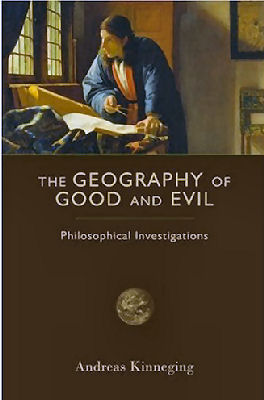
|
Posted October 21, 2009
Book: The Geography of Good and Evil: Philosophical Investigations Author: Andreas Kinneging ISI Books. Wilmington, Delaware. 2009. Pp. 285 An Excerpt from the Jacket:
Not according to fashionable thinking in the Western world. The typical modern view holds taht good and evil are merely subjective judgments, figments of the mind. But in this bacing book, the eminent Dutch philosopher Andreas Kinneging turns such thinking on its head. Good and evil, he declares, are objective, universal and unchanging. They are not to be invented, but must be discovered — or, in our age, rediscovered. In mapping the geography of good and evil, Kinneging reclaims, and reintroduces us to, the great tradition of ancient and Christian thought. That tradition is not merely of historical interest; it is of direct existential interest to us all. Traditional wisdom enables us to address the eternal questions of good and evil that confronts us in both public and private life. Though it is common to accept uncritically the blessings of modernity and its intellectual sources, the Enlightenment and Romanticism, Kinneging shows that traditional thinking is richer and more realistic. Indeed, we see how, in more than a few respects, the Enlightenment and Romanticism brought not progress but deterioration. Kinneging skillfully reformulates and defends the insights of traditional thinking for today’s readers, demonstrating how an objective morality is to be understood and how we can know what morality demands of us. At a time when the traditional virtues have practically disappeared from our language (that is, all but one — “tolerance”), he lays out the foundations of virtue and vice. Ultimately, Kinneging reveals the lasting significance of these seemingly archaic notions — to our own lives, to our families, to our culture, and to civilization. An Excerpt from the Book: When a (pagan) Greek or Roman talks about his conscience, the concept he refers to is different from the Christian one. Although it is clear from his use of the notion of conscience that he has internalized ethical criteria by which he measures his thoughts, words, and actions, the criteria are still those of the ethic of honor. The question of conscience is: will this bring me honor or shame? In the Christian concept of conscience, on the other hand, the central question is: Am I guilty or innocent? These consciences are literally worlds apart, in the sense that they view the entire world differently. Yet it is not easy to put one’s finger on those differences. A feeling of guilt is not the same as a feeling of shame. They even manifest themselves in different parts of the body and with different symptoms. It is interesting to note that we associate guilt with the sense of hearing an shame with the power of vision. We hear the verdice of guilt: we cover ourselves to avoid shame. We hear the voice of our conscience, but we lower or cover our eyes out of shame. Another indication of a fundamental difference relates to what might be called “the greatest evil.” we have already identified what must be considered bad from the perspective of the ethic of honor. Bad is when you are held in contempt, or even despised and humiliated. That is what the adherents of the ethic of honor must avoid at all costs. But the Greeks and the Romans already realized that there are people who disregard honor. Those individuals were called dishonorable or shameless. They lack a sense of honor, a sense of shame. They are beyond the ethic of honor; because the ethic has no hold over them, they represent the greatest evil. (Does this perhaps explain why the generally tolerant Romans persecuted the Christians with such severity?) In the Christian view, we also find evil defined on two levels, as it were. All transgressions of the Ten Commandments, for instance, are evil. The punishment for guilt — i.e., sin — is a bad conscience: a feeling of guilt. But there are people who do not seem to have a conscience: their actions are often described as “unconscionable,P that is, uncontrolled by the conscience. They are beyond the ethic of conscience; the ethic has no hold over them and thus they represent the greatest evil. Two notions of the greatest evil are contrasted here: lack of honor and lack of conscience. We all know what they mean and we all know how differently they are. But what exactly is this difference? Table of Contents: 1. Leisure and civilization 2. The solid darkness of the englightment 3. Inclined to all evil 4. Order out of chaos 5. Values 6. Honor and conscience 7. Tolerance and pseudo-tolerance 8. Loyalty 9. Spiritual capital 10. “Why some are called good men” 11. Justice and forgiveness 12. Justice and love 13. Virtues, duties, and rights 14. A vindication of the moral order 15. Haven in a heartless world 16. “And the two shall become one flesh 17. Public office and moral education |
|
